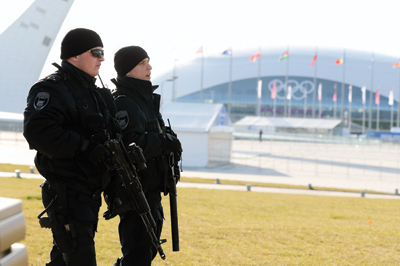Sports venues today spend billions of dollars as executives, engineers and marketers address their primary objectives of entertaining fans and filling seats. With home entertainment options growing for fans, the sports business is countering by offering an elevated fan experience that can only be found in stadiums.
Teams spare no expense to make every game day an over-the-top experience. The “showtime” effect drove a record number of eyeballs to watch the opening ceremony of the 2014 Winter Olympics in Sochi, Russia, and the Bruno Mars halftime show during this year’s Super Bowl. Yet the tone for the event is set long before such glitzy entertainment, or before any mammoth home runs or scintillating touchdowns.
It starts the second a fan arrives at the venue.
The first experience for fans is when they approach the entrance to the sporting venue and they have to go through security. Fans have been feeling the impact of an increased response to security threats in the form of additional perimeter screening and heavier restrictions on fan bags and gear. Whether due to tragic events such as the Boston Marathon last year, or due to intelligence reports about possible attacks, the trend of ever-tightening security is a reality.
The Sochi Olympic Games and Super Bowl XLVIII set the social and traditional media worlds ablaze, in large part due to the scale and seriousness of security measures there. With reports of barricades, buffer zones and even war ships, the feeling for some fans was similar to a militarized zone. While achieving fan safety and security, these drastic measures left a less-than-desirable experience for the fan upon entry.
 |
|
Heavily armed guards outside the Olympic Park in Sochi underscored the seriousness of security.
Photo by: GETTY IMAGES
|
We are reaching the point where heavy security measures are beginning to threaten the perceived and actual fan enjoyment at most sporting events.
Sports is like any business you or I frequent. If I am intimidated, hassled or uncomfortable because I can’t bring in what I need for me and my family, I may not show up, or at least not spend as freely as I would if I felt comfortable with my environment. The question is: How can fan experience from the first point of entry through the security process be improved to support, rather than work against, the amazing experience and outstanding performance waiting inside?
Let’s start by not making security the scapegoat for causing displeasure for fans, travelers and anyone affected by major events. Security, too often, has been addressed more as a bolt-on solution rather than designed with entertainment in mind. The right strategy would be to blend the more overt security measures into the event experience as seamlessly as possible. We illustrate this vision for security in the service of fan experience with the following four examples:
First, the design of the approach pathways to the sports venue can be effective in preventing fast vehicle movement while still being visually pleasing to the eye. This is seen, for example, at Walt Disney World parks in Florida, where concrete barriers were turned into attractive raised flower beds and blended into the overall park scenery.
Second, checkpoints and screening lanes can evolve into welcoming stations with a branded-event feel, complete with graphic design, sponsor insignia and multimedia. Leaders in this trend can be found outside the sports realm — for example, at the new Dallas-Fort Worth airport security check experience, where furniture, carpeting and lighting are used to transform the atmosphere while not compromising security screening whatsoever.
Third, streamline the screening process and accelerate flow. Being able to stop threats before they get inside the perimeter should not necessarily translate to adding steps and screenings. In fact, the entire process, from initial approach to ticket validation to bag and person screening, can be streamlined to cut down wait time while employing the most advanced methods for threat and prohibited-item detection.
At Qylur, we have taken the approach to combine all of these stages in one solution, using multiple parallel screening streams, automated detection and integrated ticket scanning. This solution was recently deployed at the FIFA World Cup matches in Curitiba, Brazil, where the festive feel was pervasive as enthusiastic fans went through security and actually enjoyed their experience.
Fourth, effective operations, especially for the venue of the future, will have to rely heavily on human and machine interaction, in a partnership where the best qualities of each are leveraged. A machine is capable of making thousands of decisions in the blink of an eye and can perform repetitive services with 100 percent consistency, something humans are simply not equipped to do. Human operators bring life experience, flexibility and situational judgment calls to the table. Entry-point security can benefit a lot from such collaboration.
At the World Cup deployment, collaboration played out in detection: The solution automatically screened for dangerous items, while human screeners looked for stadium-prohibited items. Another example: By automating ticket exchange and screening, staff is freed up to engage with fans, comb firsthand for threats and suspicious behavior, and facilitate a more inviting and entertaining atmosphere.
I believe that continued awareness, and examples of effective implementations, will drive venue owners and their security and operations leads to develop strategies for nonintrusive yet effective security solutions. They will team up with vendors, designers and human-factor experts, and leverage the benefits of security personnel and technologies in creative, efficient and economically sound ways. This new direction will ensure sports venues are consistently filled with fans who are truly safe and have one thing on their minds: not the threats lurking outside, but their team in the game.
Lisa Dolev (ldolev@qylur.com) is founder and CEO of Qylur.





